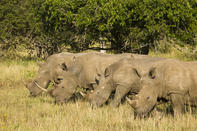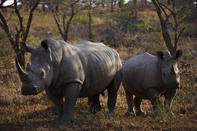Female Home Ranges
White rhino females are fairly gregarious, live with others of their own kind, and it is quite unusual to find a cow alone. A female is most often accompanied by her latest calf but sometimes the previous calf, who would have been chased off when the newest one arrived, will also accompany her.

Cows without calves will often pair up and newly independent adults may form groups of the same, or even mixed, sexes of up to five individuals. Where there is good grazing or localized water, white rhino cows and their young may form aggregations sometimes numbering ten or more.
Most of the time, female rhinos live in undefended home ranges that overlap with one another. Sometimes these home ranges can coincide with the territories of up to seven different bulls. Where there is an abundance of food and water, these ranges may be as small as 6 km² but may expand to 20 km² during dry and difficult seasons.
Territorial Bulls

White rhino bulls are fiercely territorial and are always found alone unless courting a female. Although they mature at around four years old, bulls are not usually able to contend with other bulls for territories until they are twelve years old.
So long as they demonstrate submissiveness to the older and larger territory holders, younger bulls are tolerated. A bull rhino defends an area between 0.75 and 14 km² depending on the availability of resources. His territorial boundaries typically follow natural barriers like water courses, topographical ridges and even man-made roads. When territorial bulls encounter one another along their boundaries, their responses are ritualized and posturing displays will satisfy one another of their independent statuses.
However, when there is a new territory to claim or an oestrus cow in question, bulls will fight. Their primary weapons are their horns with which they will spar and attempt to hook one another. The skin over a rhino’s shoulders is 25 mm thick to help reinforce this area against blows from opponents’ horns. Fights can be fatal.
By Megan Emmett